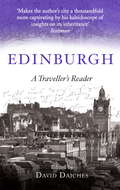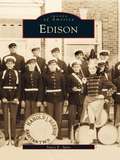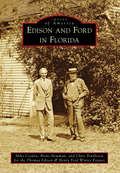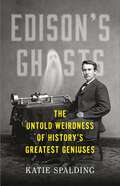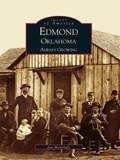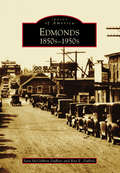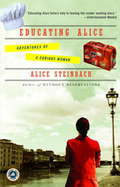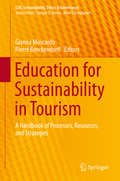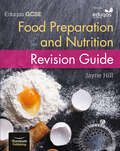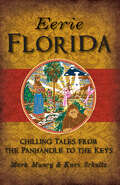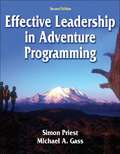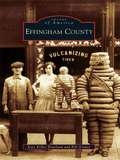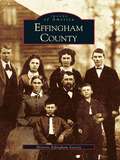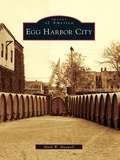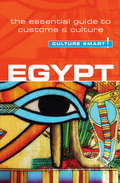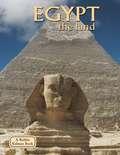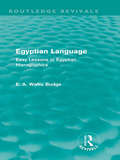- Table View
- List View
Edinburgh: A Traveller's Reader (A Traveller's Companion)
by Prof David DaichesEdinburgh is a city whose history is written on its face. The Old Town on its crowded rock, sloping down from the Castle to Holyroodhouse, has not significantly changed its atmosphere since the turbulent fifteenth and sixteenth centuries, when riots, processions, or public executions jammed the High Street. And the very different era that followed the bloody religious wars of the seventeenth century is epitomized by the elegant streets and squares of the New Town - the eighteenth-century Enlightenment whose writers, philosophers and lawyers made Edinburgh famous. This anthology of extracts from letters, memoirs, diaries, novels and biographies of interesting visitors and inhabitants, including the writings of Scott, Boswell, Cockburn, John Knox and many others, recreates for today's visitors the drama, the history, and the life of the city in buildings and places that can still be visited. The daring Scottish recapture of the Castle from the English in 1313; the confrontation between Calvinist John Knox and Catholic Mary Queen of Scots in Holyroodhouse; an eye-witness account of the execution of Montrose at the Mercat Cross in 1650; reeking slop-pails in the wynds and polite manners in the ballrooms. . .
Edinburgh: A Traveller's Reader (Traveller's Companions Ser.)
by David DaichesEdinburgh is a city whose history is written on its face. The Old Town on its crowded rock, sloping down from the Castle to Holyroodhouse, has not significantly changed its atmosphere since the turbulent fifteenth and sixteenth centuries, when riots, processions, or public executions jammed the High Street. And the very different era that followed the bloody religious wars of the seventeenth century is epitomized by the elegant streets and squares of the New Town - the eighteenth-century Enlightenment whose writers, philosophers and lawyers made Edinburgh famous. This anthology of extracts from letters, memoirs, diaries, novels and biographies of interesting visitors and inhabitants, including the writings of Scott, Boswell, Cockburn, John Knox and many others, recreates for today's visitors the drama, the history, and the life of the city in buildings and places that can still be visited. The daring Scottish recapture of the Castle from the English in 1313; the confrontation between Calvinist John Knox and Catholic Mary Queen of Scots in Holyroodhouse; an eye-witness account of the execution of Montrose at the Mercat Cross in 1650; reeking slop-pails in the wynds and polite manners in the ballrooms. . .
Edinburgh: Picturesque Notes
by Robert Louis StevensonFirst published in 1879, Edinburgh: Picturesque Notes is among the most vivid of Robert Louis Stevenson’s writings. His passion for Auld Reekie never clouded his wry wit, and his enthusiasm for the picturesque detail and the savory anecdote will delight readers today as much as they scandalized his contemporaries. Perhaps best known as the author of Treasure Island and other children’s literature, Robert Louis Stevenson was a prolific novelist, playwright, essayist, and travel writer.
Edison
by Stacy E. SpiesEdison, named for its most famous resident, inventor Thomas Alva Edison, can be called the birthplace of modern life as we know it. It was here at his Menlo Park complex that Thomas Edison created the incandescent electric lightbulb and 300 other inventions, providing residents with not only a place of employment but also a source of national pride. Known as Raritan Township until 1954, Edison was a slow-paced agricultural community until the twentieth century, with farms remaining until the 1950s. After World War II, in the country's rush to house returning war veterans, the expansive farmland became desirable real estate . Edison celebrates the township's history from its rural beginnings as a collection of small villages, to the arrival of the automobile culture on the Lincoln Highway and super highway U.S. Route 1, to its coming-of-age as a modern suburban community during the mid-twentieth century. This book combines photographs from the collections of the Metuchen-Edison Historical Society and the National Park Service, with some of the hundreds taken in the early years of the twentieth century by J. Lloyd Grimstead. Edison includes the many villages that make up the township: Oak Tree, Bonhamtown, Piscatawaytown, Stelton, New Durham, Pumptown Corners, New Dover, and Potters.
Edison and Ford in Florida (Images of America)
by Thomas Edison & Henry Ford Winter Estates Chris Pendleton Mike Cosden Brent NewmanProlific inventor Thomas Edison and automobile pioneer Henry Ford shaped the modern world like few others. The lives of these close friends intersected at their winter homes in southwest Florida. Edison first visited the tiny cattle-ranching community of Fort Myers in 1885, building a home and laboratory soon after. There, he wintered with his wife, Mina, and their children, Madeleine, Charles, and Theodore. Ford purchased the adjacent estate in 1916, wintering in the area with his wife, Clara, and son, Edsel. Here in southwest Florida, these famous neighbors relaxed and found time to explore new projects.
Edison's Ghosts: The Untold Weirdness of History's Greatest Geniuses
by Katie SpaldingPublishers Weekly Best Summer Reads Overturn everything you knew about history&’s greatest minds in this raucous and hilarious book, where it turns out there's a finer line between "genius" and "idiot" than we've previously known. &“As Albert Einstein almost certainly never said, everyone is a genius – but if you judge a fish by its ability to climb a tree, it will live its whole life believing that it is stupid.&” So begins Katie Spalding&’s spunky takedown of the Western canon, and how genius may not be as irrefutably great as we commonly understand. While most of us may never become Einstein, it may surprise you to learn that there&’s probably a bunch of stuff you can do that Einstein couldn&’t. And, as Spalding shows, the famous prodigies she explores here were quite odd by any definition. For example: Thomas Edison, inventor of the lightbulb, believed that he could communicate with the undead and built the world&’s very first hotline to heaven: the Spirit Phone. Marie and Pierre Curie, famous for discovering radioactivity, slept next to a lump of radioactive material for years and strapped it to their arms to watch it burn them in real-time. Lord Byron, acclaimed British poet, literally took a bear with him to university. Isaac Newton discovered the laws of gravity and motion, but he also looked up at the sun without eye protection. The result? Three days of blindness. Tesla, whose scientific work led to the invention of the AC unit, fell in love with a pigeon. Edison's Ghosts is filled with examples of the so-called best of humanity doing, to put it bluntly, some really dumb shit. You&’ll discover stories that deserve to be told but never are: the hilarious, regrettable, and downright bafflingly lesser-known achievements that never made it into our history books, until now.
Edmond Oklahoma: Always Growing
by Jan MattinglyFrom its humble beginnings in 1886 as a fuel and water pump house at Mile Marker 103 of the Santa Fe Railroad, through the eras of land run, statehood, oil boom, two world wars and beyond, the city of Edmond has always been growing. Today, a "beacon for the rest of Oklahoma," it boasts a vibrant community of over 70,000 residents. Edmond is home to the state's oldest continuously running newspaper, the Edmond Sun. The first church and schoolyard in Oklahoma Territory were located here, as well as the state's first institute for higher learning. Indeed, Central Normal School, now called the University of Central Oklahoma, has been at the heart of Edmond since the 1890s and is featured prominently throughout this book. Edmond is a railroad town, an oil town and a college town, depending on who you ask; but Edmondites both past and present simply know it as the "perfect town." Edmond, Oklahoma: Always Growing tells the story of this proud city through more than two hundred vintage photographs, many dating back to before the turn of the twentieth century.
Edmonds: 1850s–1950s
by Sara Mcgibbon Dubois Ray E. DuboisBefore Edmonds became a town, it was a forest of cedar trees and evergreens. The Puget Sound's various Indian tribes used the land for camping, the sea for fishing and clamming for meals, and the marshes for harvesting tules that they used to weave into items such as mats and baskets. Later, the area became known as Brackett's Landing, named after the man who began logging the forest and founded the town of Edmonds in 1890 and opened its first mills and schools. The Great Northern Railway arrived in 1891, bringing with it great prospects for commercial and residential prosperity. As the young town grew into a city, it thrived because of its location on the water. Private ferry boats called the "Mosquito Fleet" came from Seattle, and to this day, commercial and passenger ferries cross the Puget Sound to the Port of Edmonds, Kingston, and the rest of the Olympic peninsula.
Educating Alice: Adventures of a Curious Woman
by Alice SteinbachWhen Pulitzer-prize winning journalist Alice Steinbach decided to take a year off to explore Europe and rediscover what it was like to be an independent woman, she left her job, family, friends and routine behind. The result, WITHOUT RESERVATIONS, became a bestseller and inspired women everywhere to take that leap, if not in reality, at least in their imaginations. But having opened the door to a new way of living, Steinbach found herself unwilling to return to the old routine. She quit her job and left home again, only this time her objective was to find a way to combine three of her greatest passions: travelling, writing and learning. EDUCATING ALICE is the intimate, funny and richly entertaining story of her adventures roaming the world to conquer new challenges, large and small. Whether she is learning how to cook at the Hotel Ritz in Paris, tackling the intricacies of traditional Japanese arts in Kyoto, making a pilgrimage to Jane Austen's birthplace in England, uncovers the secrets of border collie training in Scotland or surrendering to the spontaneous joy of music and memories in Havana, Steinbach allows you to relish the adventure with her.
Educating Alice: Adventures of a Curious Woman
by Alice SteinbachEight years ago, Alice Steinbach, a Pulitzer Prize-winning columnist for the Baltimore Sun, decided to take a break from her life. She took a leave from job, friends, and family for a European journey of self-discovery, and her first book, Without Reservations, was the exquisite result.But once Steinbach had opened the door to a new way of living, she found herself unwilling to return to the old routine. She quit her job and left home again, only this time her objective was to ?nd a way that would allow her, personally and professionally, to combine three of her greatest passions: learning, traveling, and writing.This funny and tender book is the result of her decision to roam around the world as an informal student, taking lessons and courses in such things as French cooking in Paris, Border collie training in Scotland, traditional Japanese arts in Kyoto, architecture and art in Havana. With warmth and wit, Steinbach guides us through the pleasures and perils of discovering how to be a student again. Along the way, she also learns the true value of this second chance at educating herself: the opportunity to connect with and learn from the people she meets on her journey.From the Hardcover edition.
Education for Sustainability in Tourism
by Gianna Moscardo Pierre BenckendorffSustainability is a dominant theme in tourism practice. Increasingly, research and education of tourism stakeholders is also necessary in improving sustainable tourism practice. This book pays systematic attention to education for sustainability in tourism, and is thus a valuable resource for sustainable tourism educators and scholars. The book is divided into four parts. Part I provides a reference for educators seeking to understand core knowledge areas, ethics, corporate social responsibility and governance. Part II examines issues and processes relevant to understanding tourism and sustainability in the formal educational sector, including universities, vocational training and school settings. Part III explores learning and sustainable tourism in non-institutional settings, including destination communities, coaching and mentoring and visitor learning. The final part provides a collection of cases to illustrate the use of different pedagogies and assessment approaches in education for sustainability in tourism. The book will be accompanied by instructor resources to assist educators teaching in the field.
Education, Travel and the "Civilisation" of the Victorian Working Classes
by Michele M. StrongExamining four major institutions, Michele Strong considers the experiences of working men and women, particularly artisans, but also young apprentices and clerks, who travelled abroad as participants in an educational reform movement spearheaded by middle-class liberals.
Eduqas GCSE Food Preparation and Nutrition Second Edition
by Victoria Ellis Alison Clough-Halstead Jayne HillThis title has been submitted for endorsement by Eduqas.Build students' knowledge, develop their practical skills and equip them with the tools they need to succeed in Eduqas GCSE Food Preparation and Nutrition. Written by a leading author team, our new edition textbook has been specifically designed to provide comprehensive and engaging content to support all students to progress.- Easily deliver your course with structured and comprehensive coverage of the specification, supporting both specialist and non-specialist teachers- Enable students of all ability levels to progress, with clear layout, concise explanations, study tips and photographs, updated to ensure the content is contemporary and relevant- Build understanding of challenging areas, such as food science and application of knowledge, with revised coverage supported by pedagogy, using accessible language to break down key concepts- Develop students' culinary skills with engaging and cost-effective practical activities throughout- Consolidate learning and prepare for written assessment with short retrieval questions as well as exam practice questions, worked answers, mark schemes and commentary
Eduqas GCSE Food Preparation and Nutrition Second Edition
by Victoria Ellis Alison Clough-Halstead Jayne HillThis title has been submitted for endorsement by Eduqas.Build students' knowledge, develop their practical skills and equip them with the tools they need to succeed in Eduqas GCSE Food Preparation and Nutrition. Written by a leading author team, our new edition textbook has been specifically designed to provide comprehensive and engaging content to support all students to progress.- Easily deliver your course with structured and comprehensive coverage of the specification, supporting both specialist and non-specialist teachers- Enable students of all ability levels to progress, with clear layout, concise explanations, study tips and photographs, updated to ensure the content is contemporary and relevant- Build understanding of challenging areas, such as food science and application of knowledge, with revised coverage supported by pedagogy, using accessible language to break down key concepts- Develop students' culinary skills with engaging and cost-effective practical activities throughout- Consolidate learning and prepare for written assessment with short retrieval questions as well as exam practice questions, worked answers, mark schemes and commentary
Eduqas GCSE Food Preparation and Nutrition: Revision Guide
by Jayne HillWritten by an experienced examiner and author, the Revision Guide is endorsed by Eduqas, offering you high quality support you can trust. // It is ideal for consolidating your students' knowledge both at home for revision, and at school as a topic-by-topic summary as the course progresses. / Information is presented in a colourful and highly visual way, with numerous photos and diagrams used to explain key concepts. / It provides the essential underpinning knowledge students will need to recap and revise this new course. / Mindmaps summarise the key learning for each topic. / Grade Boost and QuickFire Questions help students reinforce and check their learning. / Important terminology is highlighted and defined throughout. / Includes practice exam-style questions with suggested answers and commentaries.
Een gids voor kinderen over Israel
by Linda HendersonIsraël is een fascinerende plek. Elk kind, elke tiener en elke volwassene moet weten waarom het Midden-Oosten belangrijk is. Als u Israël en haar buren begrijpt, zult u zien dat er meer in het Midden-Oosten is dan alleen oorlog en conflict. Dit boek kan je leven veranderen. Komt u niet op avontuur naar het Heilige Land?
Eerie Florida: Chilling Tales from the Panhandle to the Keys (American Legends)
by Mark Muncy Kari SchultzThe author of Freaky Florida shares a unique guide to the state&’s strangest attractions—from Florida Bigfoot to lost cemeteries, UFO sightings and more. Most people know Florida as the land of endless sunny beaches, Disney World, and NASA shuttle launches. But the state is also home to many hidden mysteries, eerie legends, and tales of bizarre creatures. In Eerie Florida, author Mark Muncy and photographer Kari Schultz provide a unique guide to these truly unique sites across the Sunshine State. The Everglades is home to the elusive Skunk Ape—also known as Florida Bigfoot—a strange bipedal creature recognized by its odor. An uncanny doll reputed to have a life of its own greets visitors in a Florida Keys museum. An ancient monster is reported to roam the rivers in the northeast corners of the state, and in South Florida, a man built Coral Castle—also known as America's Stonehenge—via mysterious means. Join Mark Muncy and Kari Schultz as they uncover the history behind the state's creepiest stories and unusual locations.
Effective Leadership In Adventure Programming
by Simon Priest Michael A. GassEffective Leadership in Adventure Programming, Second Edition,explains how the key elements of leadership work in theory and practice, and it helps train the next generation of adventure leaders--training that is paramount to developing the field. Through this text, readers will enhance their understanding of this rapidly growing profession. Renowned authors Simon Priest and Michael Gass provide in-depth descriptions and real-world applications of the technical, organizational, instructional, and facilitative skills that are essential to adventure leadership. The authors also identify what they call the metaskills that superior leaders use to combine the other essential skills seamlessly and effectively. The authors provide fully updated content and references, including new information on legal liability, risk management skills, and future research trends in adventure programming.
Effingham County (Images of America)
by Kate Keller Bourland Bill GrimesThe history of Effingham County is closely tied to the development of transportation through America's heartland. Beginning with the old National Road, through the golden age of railroads, onward to today's interstate highway system, the county has developed alongside the nation's great transportation innovations. Given the county's location between Chicago to the north, St. Louis to the west, and Indianapolis to the east, it is easy to justify the "Heart of the USA" and "Crossroads of America" designations. Effingham County, however, is more than railroad yards and highway interchanges. This book shows the rich fabric of life woven throughout the history of the city of Effingham and smaller towns, including Teutopolis, Altamont, Beecher City, Dieterich, Watson, Mason, Edgewood, Montrose, and Shumway.
Effingham County (Images of America)
by Historic Effingham SocietyOn March 12, 1734, German Salzburger immigrants arrived in the southern portion of Georgia where, with handmade bricks, they constructed the Jerusalem Lutheran Church. Within its hallowed walls an active congregation still worships today, and the community that flourished around this sacred landmark is now known as Effingham County. The founding fathers of the early settlement also established a gristmill, a sawmill, a school, and an orphanage, bringing to life the optimistic sentiments they had carried across an ocean and into a new world. Effingham County celebrates, in word and image, the spirit and achievements of these industrious pioneers, who forged a special relationship with the land on which they settled. While religion was a focal point of the new community, commerce and industry could not be overlooked in a young America poised for an unprecedented role on the world's stage. The rivers that flowed through the county, the Savannah and the Ogeechee, made it possible for the local residents to transport their cotton and timber to the bustling markets in Augusta and Savannah; later, major railroad lines would pass through the county, connecting it to economic opportunity in the rest of the state and beyond. Today, Effingham County is made up of several small towns, with Springfield designated as the county seat. The people who live, work, and worship in these towns are ever respectful of the contributions of their hardworking ancestors, and maintaining the integrity of the community's unique character is a shared and enjoyed civic responsibility.
Egg Harbor City (Images of America)
by Mark W. MaxwellEgg Harbor City was founded as a refuge from the sweeping nativism of the Know-Nothings, a group that tried to limit immigration and naturalization into the United States. Egg Harbor City was a place where German Americans could maintain the traditions, language, and lifestyle of their fatherland. The city was designed in rectangular blocks with lots for building, gardening, or farming. Parks were built and a harbor was planned on the north side of the city with rail lines connecting it to the Camden and Atlantic Railroad. Following the 1876 Centennial Exhibition in Philadelphia, Egg Harbor City's wines earned the community great respect, and it became known as the "Wine City," drawing hundreds of visitors to its many wineries. Egg Harbor City celebrates the early years of the place once known as the most German city in the United States of America.
Egypt (La Mort de Philae)
by Pierre LotiClassic work from the French sailor who travelled extensively and achieved popularity with his impressionistic romances of adventure in exotic lands. The title refers to an ancient island temple in Upper Egypt.
Egypt: Culture Smart!
by Jailan ZayanThe best-selling Culture Smart! series continues where other guides leave off. Whether you are travelling on business or pleasure, long-term or short, Culture Smart! is your pocket-sized cultural roadmap that never goes out of date. Providing essential information on attitudes, beliefs and behaviour in different countries, these concise guides enable you to steer clear of embarrassing mistakes, feel confident in unfamiliar situations, and arrive at your destination with local knowledge on what to expect and how to behave. Culture Smart! has become as essential as remembering to pack your passport. Be a responsible traveller with Culture Smart!, the smarter way to travel.
Egypt: The Land (Lands, People and Cultures)
by Arlene MoscovitchEgypt is a land of timeless monuments and artifacts. It is also a land marked by the changes brought by the modern world; where camel drivers talk on cell phones and ancient tombs are moved to make way for modern dam building projects. With photographs, this work addresses the problems of pollution, global warming, and erosion on the land.
Egyptian Language: Easy Lessons in Egyptian Hieroglyphics (Routledge Revivals)
by E.A. Wallis BudgeSir E. A. Wallis Budge (1857-1934) was Keeper of the British Museum’s department of oriental antiquities from 1894 until his retirement in 1924. Carrying out many missions to Egypt in search of ancient objects, Budge was hugely successful in collecting papyri, statues and other artefacts for the trustees of the British Museum: numbering into the thousands and of great cultural and historical significance. Budge published well over 100 monographs, which shaped the development of future scholarship and are still of great academic value today, dealing with subjects such as Egyptian religion, history and literature. The ancient Egyptians expressed their ideas in writing by means of hieroglyphics, which they used uninterruptedly until the end of the rule of the Ptolemies. Evidence indicates that the hieroglyphic system of writing was brought to Egypt by invaders from north-east or central Asia; they settled somewhere between Memphis on the north and Thebes on the south, and gradually established their civilization, religion and methods of communication. First published in 1910, Egyptian Language provides a simple introduction to the study of Egyptian hieroglyphic inscriptions. Including an account of the decipherment of the hieroglyphic system and the general principles which underlie it, as well as the main facts of ancient Egyptian grammar and illustrative extracts, the book will be of value to students and academics of ancient Egyptian language and culture.
